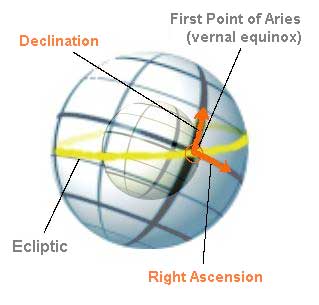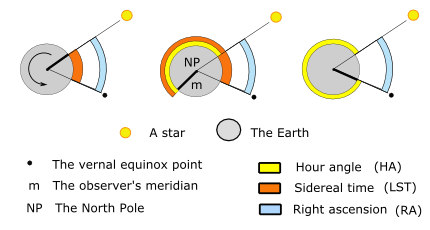|
The equatorial coordinate system is probably the most widely used celestial coordinate system, whose equatorial coordinates are: * declination (δ) * right ascension (α) -also RA-, or hour angle (H) -also HA- It is the most closely related to the geographic coordinate system, because they use the same fundamental plane, and the same poles. The projection of the Earth's equator onto the celestial sphere is called the celestial equator. Similarly, projecting the geographic poles onto the celestial sphere defines the north and south celestial poles. There are two systems to specify the longitudinal (longitude-like) coordinate: * the hour angle system is fixed to the Earth like the geographic coordinate system * the right ascension system is fixed to the stars, thus, during a night or a few nights, it appears to move across the sky as the Earth spins and orbits under the fixed stars. Over long periods of time, precession and nutation effects alter the earth's orbit and thus the apparent location of the stars. When considering observations separated by long intervals, it is necessary to specify an epoch (frequently J2000.0, for older data B1950.0) when specifying coordinates of planets, stars, galaxies, etc.
Left A star is at culmination on an observer's meridian (HA = 0 h), then RA = LST. Right Now the vernal equinox point is at culmination on the meridian m (LST = 0 h) (Positive angles: RA, counterclockwise; HA and LST, clockwise) The latitudinal (latitude-like) angle of the equatorial system is called declination (Dec for short). It measures the angle of an object above or below the celestial equator. The longitudinal angle is called the right ascension (RA for short). It measures the angle of an object east of the vernal equinox point. Unlike longitude, right ascension is usually measured in hours instead of degrees, because the apparent rotation of the equatorial coordinate system is closely related to sidereal time and hour angle. Since a full rotation of the sky takes 24 hours to complete, there are (360 degrees / 24 hours) = 15 degrees in one hour of right ascension. The equatorial coordinate system is commonly used by telescopes equipped with equatorial mounts by employing Setting circles. Setting circles in conjunction with a star chart or ephemeris allow a telescope to be easily pointed at known objects on the celestial sphere. Retrieved from "http://en.wikipedia.org/"

|
|
||||||||||

